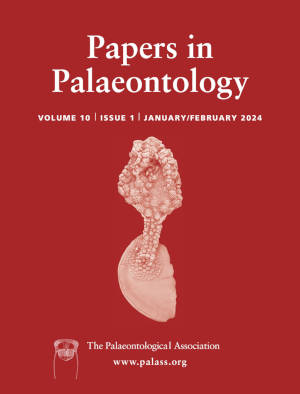Article: Rostral and body shape analyses reveal cryptic diversity of Late Jurassic batomorphs (Chondrichthyes, Elasmobranchii) from Europe
Publication: Papers in Palaeontology
Volume:
10
Part:
2
Publication Date:
2024
Article number:
e1552
Author(s):
Julia Türtscher, Patrick L. Jambura, Eduardo Villalobos-Segura, Faviel A. López-Romero, Charlie J. Underwood, Detlev Thies, Bruce Lauer, René Lauer, and Jürgen Kriwet
DOI:
10.1002/spp2.1552
Abstract
Abstract The fossil record of chondrichthyans (chimaeras, sharks, rays and skates) consists largely of isolated teeth, with holomorphic specimens being extraordinary exceptions. However, numerous of these more or less completely preserved specimens are known from several Upper Jurassic deposits of Europe, enabling detailed analysis of their morphology. Batomorphs (rays and skates) resembling modern guitarfishes and wedgefishes (Rhinopristiformes) are among the most common Jurassic chondrichthyans found, but they have been only sporadically studied up to now, resulting in large knowledge gaps concerning their taxonomy and phylogeny. Here, we present the most detailed revision of Late Jurassic holomorphic batomorphs to date, quantitatively analysing body proportions of specimens from Germany (Solnhofen Archipelago), France (Cerin) and the UK (Kimmeridge), using both geometric and traditional morphometrics. Furthermore, we identify qualitative morphological characters for species discrimination, to clarify the taxonomic identity and diversity of Late Jurassic batomorphs based on holomorphic specimens. Our results support the validity of Belemnobatis sismondae, Kimmerobatis etchesi and Spathobatis bugesiacus, as well as that of the previously doubtful Asterodermus platypterus. Moreover, we describe Aellopobatis bavarica, a new taxon, which has hitherto been considered to be a large-sized morphotype of Spathobatis bugesiacus. Our results highlight that the diversity of holomorphic batomorphs during the Late Jurassic was greater than previously thought, and suggest that this group was already well-established and diverse by this time. This study thus provides vital information about the evolutionary history of Late Jurassic batomorphs and has direct implications for batomorph species that are based on isolated teeth only.
